DIRECTORS AND THEIR ACTRESS WIVES
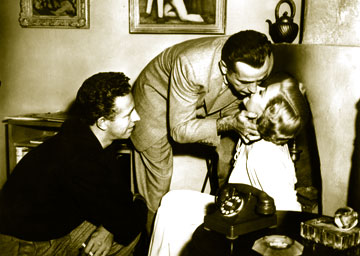
Nicholas Ray directing actress & wife Gloria Grahame and Humphrey Bogart in “In a Lonely Place” (1950) Photo courtesy of Photofest.
Cinema and Romance is in the air. So, the theme for trivia 59 will be devoted to film directors who directed their own actress wives.
No one will see your answer except for you.
For more on cinema, see Traveling Boy's The 20 Best Films of 1971, Part One

Congratulations!
You have completed DIRECTORS AND THEIR ACTRESS WIVES.

You scored %%SCORE%% out of a possible 5 points.
Your performance was: %%RATING%%
Question 1 |
A | Anouk Aimee |
B | Claudia Cardinale |
C | Sophia Loren |
D | Anna Magnani |
E | Giuletta Masina |

Federico Fellini and Giuletta Masina in Venice.
Courtesy: IMDB.Com
EXTRAS: Italian film icon Federico Fellini directed actress and wife Giuletta Masina in seven movies. They were married from 1943 until his death in 1993. They had one child. Together they are buried in the same tomb in Rimini, Italy, Fellini’s place of birth.
Giulietta Masina (1921–1994) was born in San Giorgio di Piano, Italy, and spent part of her teenage years living in Rome, where she cultivated a passion for the theater and studied for a degree in philosophy. She began her career with popular radio shows with scripts written by Fellini. The following year she married Fellini and became the inspirational muse for many of his films.

Giuletta Masina in Nights of Cabiria.
Courtesy: IMDB.Com.
In Fellini’s 1950’s period, he was influenced by Charles Chaplin and the director’s theme of the road. In a sense, Giuletta Masina played Chaplin’s Little Tramp in La Strada (1954) and Nights of Cabiria (1957). Both films won Academy Awards for Best Foreign Language Film. Fellini described the two films as having been "inspired" by Masina's "humanity."
Federico Fellini & Giulietta Masina Filmography
- Variety Lights (1950) Co-directed with Alberto Lattuada.
- The White Sheik (1952)
- La Strada (1954)
- Il Bidone (1955)
- Nights of Cabiria (1957)
- Juliet of the Spirits (1965)
- Ginger and Fred (1986)
Question 2 |
A | Juliet Berto |
B | Isabelle Huppert |
C | Anna Karina |
D | Marie-France Pisier |
E | Romy Schneider |

EXTRAS:
Jean-Luc Godard first noticed Anna Karina in a Palmolive ad and tried to cast her in a cameo role in his first feature film, Breathless (1960). She was told that she had to be nude and refused to play in the movie. A few months later, Godard offered her another part in his second film, Le Petit Soldat, (made in 1961, but not released until 1963 due to the political content of the war in French Algeria). Later they were married in 1961. They made seven features and one short sketch film together, and she became famous as the face of the Nouvelle Vague.

Hanne Karin Bayer (1940–2019) was born in Denmark, and at age seventeen hitchhiked to Paris and learned French by going to the movies. She soon met Coco Chanel and Pierre Cardin and became a popular model. Upon her meeting with Godard she decided to focus on screen acting and ended up appearing in seven features and one short sketch film by him. Fluent in five languages: French, Danish, English, Swedish and Italian, she has worked with the film directors Agnès Varda, Jacques Rivette, George Stevens, Volker Schlöndorff, George Cukor and Rainer Werner Fassbinder.
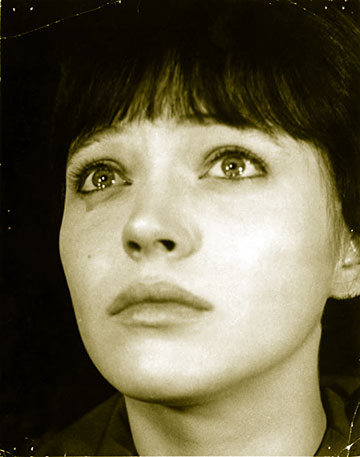
Anna Karina in My Life to Live (1962). Courtesy: IMDB.com.
"A whole book could also be written about the evolution of Karina’s close-ups in Godard’s films—how they go from fascination, to observation, to careful adoration and finally to nostalgia. But her relation to the camera also changes, as the relationship with the man behind it does—from shyness to content comfort in front of it, from sensuality to coldness, from ignoring it to commanding it. The exchange of looks mediated by the camera is varied and extremely nuanced. – Miranda Popkey, the hairpin."
Jean-Luc Godard & Anna Karina Filmography
- Le Petit Soldat (1961)
- A Woman Is a Woman (1961)
- Vivre Sa Vie (1962)
- Band of Outsiders (1964)
- Alphaville (1965)
- Pierrot le Fou (1965)
- Made in U.S.A (1966)
- The Oldest Profession (1967) Sketch film.
Question 3 |
A | Claire Bloom |
B | Virginia Cherrill |
C | Paulette Goddard |
D | Edna Purviance |
E | Martha Raye |

Charles Chaplin and third wife, Paulette Goddard. Courtesy: IMDB.com
EXTRAS:
Paulette Goddard met Iconic director, writer and actor Charles Chaplin in 1932. Goddard mesmerized Chaplin with her stunning natural beauty and soon they became an item in Hollywood. They secretly married the first week in June, 1936, in Canton, China, while on a world cruise. He eventual said, "I am writing a screen play for you, and its title is Modern Times.
Marion Goddard Levy (1910–1990) was born in Whitestone Landing, New York. She began to model for local department stores before she made her debut with Florenz Ziegfeld's Follies at the age of 13, where she gained fame as the girl on the crescent moon. She moved to Hollywood at age sixteen, and appeared in small film roles. Goddard was still working for less than $100 a week as a chorus girl for the Goldwyn Studios. Chaplin was true to his word, and cast her in Modern Times (1936), which was a big hit, but her movie career was not going anywhere because of her relationship with the controversial Chaplin. They made a second film in 1940 together, The Great Dictator; Chaplin’s first complete sound film.
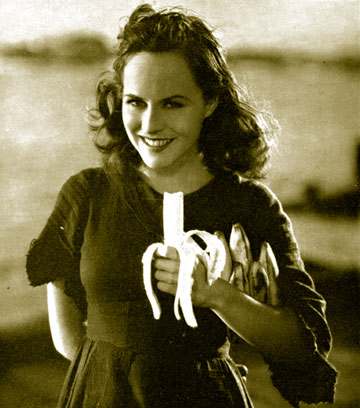
Paulette Goddard in Modern Times.
Courtesy: IMDB.Com.
Working together on Modern Times put a strain on Chaplin and Goddard's relationship. Contrary to the way young actresses were presented on screen, Goddard was to wear shabby clothing and no make-up. When she first arrived on the set with her beautifully coiffed hair, Chaplin dumped a bucket of water over her head. He insisted that she either be barefoot or wear shoes without heels to ensure that she is always shorter than his 5 ft 4 Little Tramp.
Chaplin then cast Goddard in the leading female role in his first all-sound, all talkie film, The Great Dictator (1940.) He named her character after his mother, Hannah, where she played a cleaner. He insisted that she scrub the floor of the whole set only for her to refuse. Chaplin stopped filming until she agreed to do so. Their relationship was already on the rocks, and the couple split shortly after the 1940 premiere of their film. Goddard obtained a quickie divorce in Mexico and allegedly received a handsome settlement. The 54-year-old Chapin married wife number four, 18-year-old Oona O'Neill, daughter of playwright Eugene O'Neill, while Goddard’s husband number three was actor Burgess Meredith.
Charles Chaplin & Paulette Goddard Filmography
- Modern Times (1936)
- The Great Dictator (1940)
Question 4 |
A | Isabelle Adjani |
B | Stéphane Audran |
C | Emmanuel Berat |
D | Dominque Sanda |
E | Isabelle Hupert |
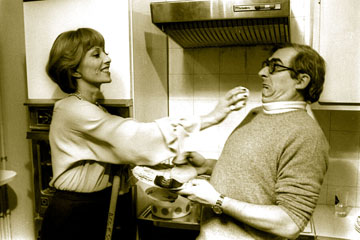
Stéphane Audran and husband, director & gourmet chef Claude Chabrol in the kitchen. Courtesy: IMDB.Com
EXTRAS: French director Claude Chabrol cast Stéphane Audran in his second film, Les Cousins. They started to date which led to a 1964 marriage which lasted for 16 years until divorce. They had one child together. Chabrol later commented, “I found myself becoming more interested in her as an actress than a wife.” Audran frequently stated she owed everything to Chabrol. With the success of Audran’s role in Chabrol’s Les Biches (1968), he started to cast her in roles of glacial bourgeois ladies, the epitome of Parisian chic. This led the two of them to a successful cycle of thrillers in the late 60s-early 70s. Colette Suzanne Jeannine Dacheville was born in Versailles, Seine-et-Oise [now Yvelines], France in 1932. Having taken acting lessons, she appeared in theatrical productions, but failed to build a noteworthy stage career. After playing a few tiny roles on film, she asked emerging French New Wave star Gérard Blain, whom she knew from acting courses, if he could introduce her to director Claude Chabrol. Blain had already acted in Chabrol’s successful first film, Le Beau Serge (1958), and was going to team up again in The Cousins (1959). Blain granted her wish and introduced her to Chabrol, who gave her a role in Les Cousins. They made 24 films together.

Stéphane Audran was the very essence of Parisian chic during the Nouvelle Vague. Courtesy: IMDB.Com
While Stéphane Audran is best known for her performances in films by Chabrol, she also appeared in Luis Buñuel’s Academy Award winning, The Discreet Charm of the Bourgeoisie (1972); Samuel Fuller’s The Big Red One (1980) and Babette’s Feast (1987), the first Danish movie to win an Academy Award for best foreign language film. She died at the age of 85 on March 27, 2018 in Neuilly-sur-Seine, Hauts-de-Seine, France.
Question 5 |
A | Ingrid Bergman |
B | Claudia Cardinale |
C | Sophia Loren |
D | Anna Magnani |
E | Jean Seberg |

Roberto Rossellini and Ingrid Bergman at Cannes Film Festival.
Courtesy: IMDB.Com
EXTRAS: Ingrid Bergman was one of the greatest actresses from Hollywood's lamented Golden Era. Her stunning natural beauty and immense acting talent made her one of the most celebrated figures in the history of American cinema. Great performances result from an actor’s collaboration with great directors, and Ingrid Bergman went further—and sacrificed more—than did any other actor in order to work with a true cinematic genius, Italian director Roberto Rossellini. While at the peak of her popularity, Bergman was so taken upon seeing Rossellini’s Italian neorealism films, Rome, Open City (1945)and Paisan (1946), that she sent the director a letter, introducing herself and offering her talents in any film of his choice.
Ingrid Bergman was born on August 29, 1915 in Stockholm, Sweden, to a German mother who died when she was only two, and a Swedish father that passed away when she was twelve. After finishing formal schooling, she enrolled at the Royal Dramatic Theatre School in Stockholm but decided that screen acting was her passion. In 1936, Bergman appeared in the Swedish film, Intermezzo, which caught the eye of American producer David O. Selznick, who signed her to a contract. She moved to California and reprised her original role in an English language remake of Intermezzo (1939). The film was a hit and so was Bergman.
Her beauty was infectious and her acting and attention to craft indicated to moviegoers that her films represented a tradition of quality. Her impressive performances and awards were seemingly endless, appearing in Casablanca (1942), For Whom the Bell Tolls (1943), an Oscar-winning performance in George Cukor’s Gaslight (1944), and three films by Alfred Hitchcock. But it was her portrayal of a nun in Leo McCarey’s The Bells of St. Mary's (1945) and title role in Joan of Arc (1948) that cemented her off-screen image to the public as a moralistic, saint-like character which she played on the screen. But that was before Rossellini.
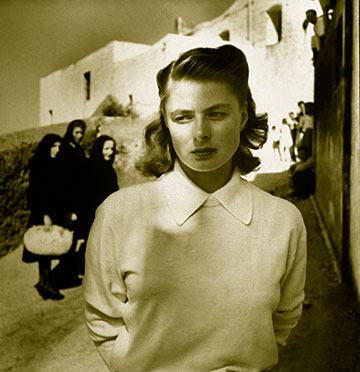
Ingrid Bergman as displaced war victim in Roberto Rossellini’s Stromboli. Courtesy: IMDB.Com
In 1949 Bergman arrived in Italy to film Stromboli (1950) with Rossellini, and they quickly fell in love with each other. Bergman left her husband, Petter Lindström, and their young daughter, Pia Lindström, to live with Rossellini. When she and Rossellini made Stromboli, Bergman was pregnant with his child. She divorced Lindström, but the divorce hadn’t yet come through, and America's "moral guardians" were outraged. She decided to remain in Italy, where a son was born, followed by twins, Isotta and Isabella Rossellini, who became a world-famous model and actress, and later spouse of American director Martin Scorsese.
Bergman was denounced in the press, in pulpits, and even in the Senate; local officials called for boycotts on all of her films, and it was beside the point whether she was persona non grata in Hollywood, because she had no intention, at the time, of working in Hollywood again.
Together, Bergman and Rossellini made six films that are works of both sociopolitical concern and metaphysical melodrama, each starring Bergman as a woman experiencing physical dislocation and psychic torment in post-World War Two Italy.
In 1957 they divorced, partly due to Rossellini not wanting her to work with any director other than himself, which caused trouble in their work together and marriage. Plus, Rossellini had an extramarital affair with the Indian screenwriter Sonali Senroy DasGupta whom he later married. Ingrid continued to make films in Italy and finally returned to the English-speaking world in the title role in Anastasia (1956) to applause and forgiveness, and winning her second Academy Award. She continued to bounce back and forth from Europe and Hollywood, culminating in her final big-screen performance in 1978's Swedish film Autumn Sonata, directed by fellow Swede Ingmar Bergman, where she received her final Academy Award nomination. Ingrid Bergman died from cancer in 1982 on her 67th birthday.
Roberto Rossellini & Ingrid Bergman Filmography
- Stromboli (1950)
- Europe '51 (1952)
- We, the Women (1953)
- Joan of Arc at the Stake (1954)
- Fear (1954)
- Journey to Italy (1954)
